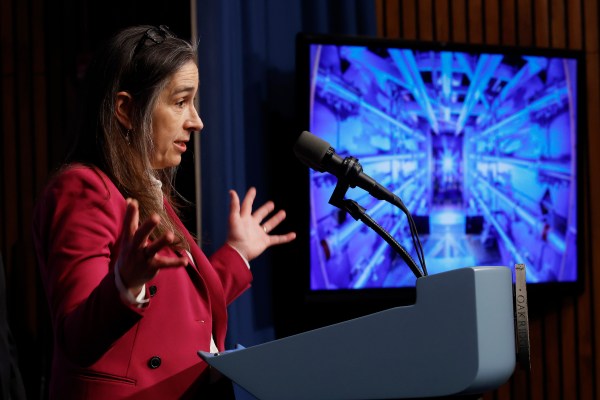It’s official: A U.S. Department of Energy lab produced a controlled nuclear fusion reaction that released more energy than it consumed.
On December 5, just after 1:03 a.m. PT, 192 lasers at the National Ignition Facility converged on a small gold cylinder that contained a tiny bead of fuel composed of two isotopes of hydrogen, deuterium and tritium. In a flash, the cylinder vaporized, emitting X-rays that bombarded the fuel pellet, turning its outer diamond layer into an expanding plasma that compressed the fuel inside to the point where its nuclei fused and released a tremendous amount of energy.
How much energy?
When the BB-sized fuel pellet ignited and produced a sustained fusion reaction, it released about 50% more energy than was imparted by the experiment’s lasers — the world’s largest and most energetic laser system. The lasers’ energy heated the fuel pellet to 150 million degrees Celsius and compressed it with a pressure over twice that found at the sun’s center.
In specific terms, the lasers put in 2.05 megajoules of energy and the fusion reaction released 3.15 megajoules. That’s even better than leaked reports suggested. The team at the Lawrence Livermore National Laboratory spent the last week deciphering the data to determine the exact results.
Only 4% of the deuterium-tritium fuel burned in the fusion reaction, suggesting plenty of room for improvement. The gold cylinder took about two weeks to manufacture, and the diamond-coated fuel pellet took about seven months to produce.
In scientific and technical terms, the reaction is considered net positive. In real-world terms, it produced far less power than what would be expected of a commercial power plant. To produce the 2.05-megajoule shot, the laser system required 300 megajoules of power, Kim Budil, director of LLNL, said in a press conference today.
Still, Budil said that the team sees a way to get to “hundreds of megajoules of output” per shot, an amount that would be required for a commercial-scale power plant using the technique, known as inertial confinement.
“We need the private sector to get into the game,” Energy Secretary Jennifer Granholm said.
While a few fusion startups are focused on inertial confinement, the majority are pursuing magnetic confinement, which uses powerful superconducting magnets to corral burning plasma to the temperatures and pressures required for fusion.
The fundamental underlying physics are the same for the two approaches, but the rest of the science and engineering challenges are quite different. In the fusion research world, magnetic confinement is considered low temperature and low pressure, whereas inertial confinement is high temperature and high pressure. Still, there are many places where work on one side benefits the other and vice versa, Carolyn Kuranz, an experimental plasma physicist at the University of Michigan, told TechCrunch yesterday.
The opportunities for shared knowledge have investors heartened, too. “Fusion science has been making steady progress toward energy breakeven on a number of fronts for decades,” said Phil Larochelle, a partner at Breakthrough Energy Ventures. “We expect other approaches to make similar breakthroughs this decade, paving the way for commercial plants in the near future.”
The team had a hunch that last week’s shot would be a good one, though they had no idea just how good until the diagnostic data started rolling in. The first thing that principal experimentalist Alex Zylstra did when he saw the initial data was to call a diagnostic expert to double-check whether it was really as good as he thought.
By the morning, the rest of the team woke up to the promising news, and by the next week, they knew they had achieved a world first.
The shot was the result of refinements put in place after successful experiments in August 2021 and earlier this year. The string of successes was enabled not only by data from previous experiments, but also machine learning trained on that data, Budil said.
When it comes to a timeline for commercializing inertial confinement, Budil remains a realist but is growing increasingly optimistic. Now that the theory has been proven, she sees where specific advancements, from targeting improvements to laser efficiencies, could help bring it to market.
Commercial fusion remains “probably decades away,” she said. “Not six or five as we used to say, but moving into the foreground. A few decades of research into the underlying technologies could put us in the realm of a commercial power plant.”
